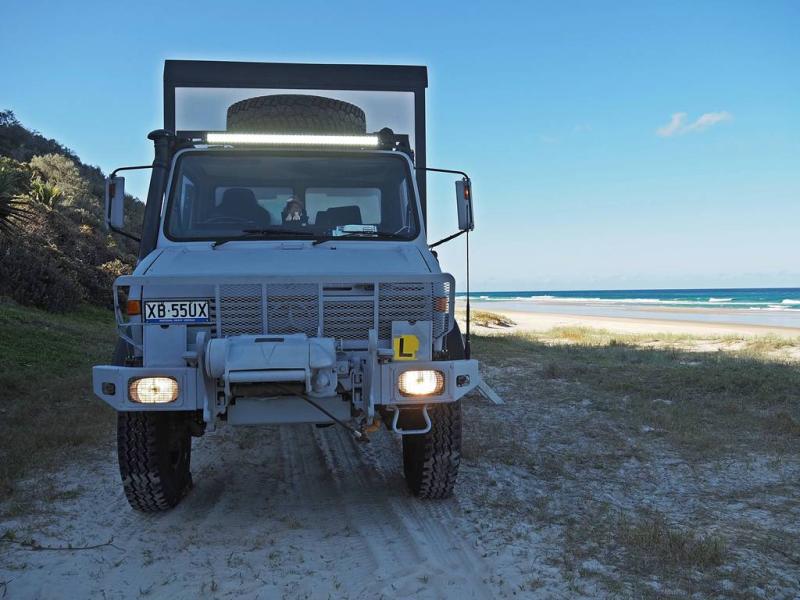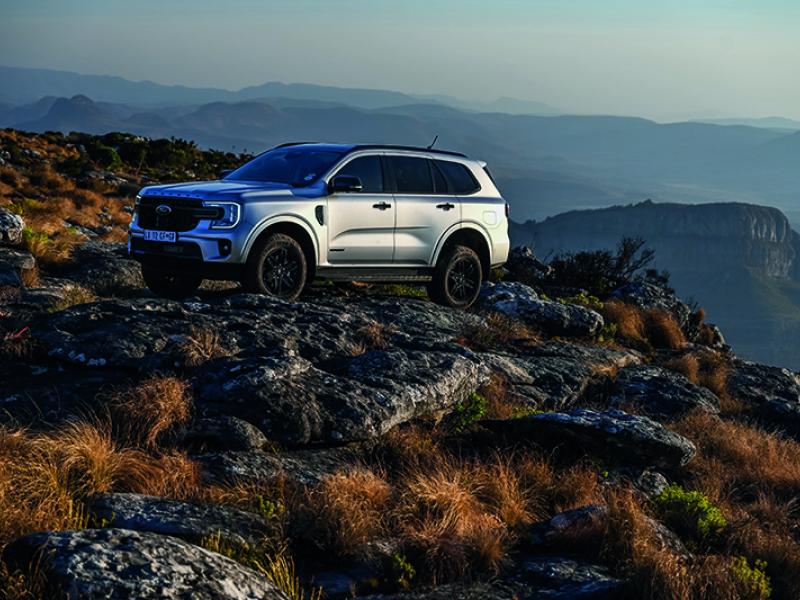Aaron Rich and his overlanding family had a dream run – mechanically-speaking – until their Mitsubishi Pajero ground to a halt on what was to be their third to last day in Russia ...
My previous instalment in this series took readers as far as Moscow. We’d found (just) enough diesel to make it across Uzbekistan’s fascinating ancient desert region, then back into Kazakhstan and again into Russia (for the third time!).
We then spent a very enjoyable four days in Moscow. It’s a wonderful city to explore and we could easily have enjoyed a longer stay here, but we needed to press on. And so, on Friday 13th December 2019, we departed Moscow bound for St Petersburg, feeling fortunate to be among the first motorists to use Russia’s new 130km/h M11 Motorway. This would make reaching St Petersburg the same day relatively easy, or so we thought. We nearly made it, but then ... disaster struck!
Some Background First
I previously indicated that next up (this article) you’d see how we got on handling a disaster that occurred near the end of this trip. Despite the considerable planning and preparation that goes into these foreign overland adventures, I know well to anticipate that not everything will go to plan.
Looking way back on our initially troubled 2014 expedition to Morocco (North Africa), this being at a time when I was a considerably less experienced player at this game, there it wasn’t the Pajero that let us down so much as local mechanics.
I employed one simply to replace a wheel bearing, but his surprisingly poorly equipped team managed to break almost everything around the wheel bearing in the process, thus requiring another mechanic at the next town to attend to the newly acquired damage.
They too performed generally awful work and, for reasons unfathomable, chiselled off the front pair of expensive wheel speed sensors! Those now historic events marked an important turning point in my development as a 4WD overland adventurer, chiefly because I came to recognise the importance of learning to do all my own mechanical work.
Prevention always better, but….
Preventing a mechanical catastrophe is a far better proposition than finding yourself in the position of having to work out what the heck you’re going to do to resolve a very tricky situation, somewhere remote… bearing in mind that my idea of ‘remote’ can include places like the Gobi or Sahara Deserts.
By ‘mechanical catastrophe’ I’m not talking about things like failed wheel bearings, driveshafts or suspension components, etc. These things likely constitute a ‘breakdown’ in the eyes of most motorists, but I believe the suitably equipped overland adventurer should be capable of attending to most mechanical repairs ordinarily. To this end we travel with quite a selection of spare parts and comprehensive tools. So, by ‘catastrophe’, I mean the big things; I can’t bring a spare engine or gearbox.
And how do you keep the big things running reliably on a vehicle that’s mostly operating in harsh conditions? You start with a vehicle known for inherent reliability and you keep it perfectly (and preventatively) maintained. Taking it a step further, I like to build in early warning systems.
A good example is my entirely aftermarket fuel filtration system that removes potentially destructive contaminants from the poor-quality fuel sometimes found in less developed countries.
A sensor inserted into the primary filter will trigger a loud alarm – hard wired and stuck to the dashboard – should water be detected. Even a small amount of water in the diesel can cause a common rail fuel pump to literally blow up – not a roadside repair ... a catastrophe!
I also stream data wirelessly from the engine computer to software running on a tablet, with further alarms set to sound if key parameters go outside normal specification. The most important parameters to monitor are temperatures at the engine, gearbox and exhaust. Early detection of an overheat condition should allow time to stop before major damage occurs. So, I have a pretty good handle on all aspects vehicle related… what could possibly go wrong!?
What Went Wrong
If you’re going to clock up as many miles as we do, there’s ample opportunity for an unusual event to eventually occur. It appears the heat exchanger I use to recycle waste engine heat into hot water for showering (a quality unit that has performed well for years) ruptured. It would only have taken a minute for all the engine coolant to pump out onto the ground, unnoticed, and only another minute or so for the engine to begin to dangerously overheat… also unnoticed! It turns out my software-based monitoring system, which had until then always operated reliably, had shutdown at a most inconvenient time!
That said, these events have caused me to reconsider whether my electronic system would have triggered in time anyway, as it relied on the OEM coolant temperature sensor, which would have quickly found itself without any coolant to measure. It’s beyond the scope of this article, but I’ve since installed a far more dependable early warning system that I may write about in future. Whilst my new system could have prevented most of the turmoil discussed next, it will only assist me in future.
As things stood on that dark, cold and snowy night, stranded at the side of a lonely Russian highway with a blown engine, what had happened had happened and there was simply no changing it!
A Reality Check
and the Bigger Picture
Thoughts of the looming major repair bill, the significant setback to our trip, and kicking myself for how I could/should have been capable of avoiding this, were soon outweighed by a more pressing concern.
Our most recent entry into Russia had been on 10-day transit visas and we now had just 72 hours remaining to comply with our obligation to leave Russia, with the crippled Pajero. I began this trip with a misconceived notion that in such a scenario Russian Immigration Police would be understanding of our predicament and thus display leniency. Though I believe that is what would happen in similar circumstances for a visitor to New Zealand, it’s just not how things are in Russia, and many other countries.
For instance, a motorbike adventurer I followed when initially researching for this trip was held in detention in Russia and threatened with a lengthy prison sentence – all for a two day overstay, which arose because he cracked his motorbike chassis and struggled to find an aluminium welder. So, don’t underestimate the amount of trouble a foreigner can get into for failing to exit some countries by their (non-extendable) visa expiry! The penalties sometimes applied can seem terribly disproportionate.
Russian authorities are most unlikely to consider any severity of vehicle mechanical breakdown to constitute a valid reason to overstay. You would need to be seriously ill in a hospital bed before you’d receive any leniency on your expiring immigration status in Russia. There is a very real possibility of being detained, or restricted to the city nearest the border you attempted to exit, until your court case is prepared… yes, court case! This alone could take weeks. Much can depend on the individual you strike at the border, as for very minor breaches they may have scope to vary the rules, if they’re feeling so inclined.
Advice for Kiwis abroad given on the New Zealand Government’s safe travel website isn’t encouraging either. It correctly points out that the NZ Government has no sway in what a foreign Government does with you on their soil, and much of the advice given concerns making yourself a model prisoner!
Suggestions include: “adapt to conditions in the local prison as quickly as possible and consider taking up any educational, work, or counselling opportunities that might be available.”
Who knows, perhaps with good behaviour you’ll qualify for early release, and those prison courses might boost your CV too!
‘It’s Russia!’
So, back to us at the side of that remote, lonely stretch of Russian motorway, on a cold dark snowy Friday night, with a cooked engine and just 72 hours to get out of Russia. By the time a helpful motorist came past, sometime after midnight, and stopped to check if we were ok, we were able to tell him that we’d used our extremely weak cell reception to call the motorway assistance phone number and had been assured a tow truck was coming. (Sylwia’s Russian language skills proving their worth again!)
Actually, we’d twice repeated that process and twice been told a truck was just minutes away… yet one never arrived?! The helpful Russian motorist confidently proclaimed that no truck was coming. I enquired how he could be so sure? “It’s Russia!” came his answer. And he was right – no one came for us other than his mechanic friend, who lived about 45 kilometres away in a historic town called Veliky Novgorod.
Sergei the mechanic turned up in his old Lada and kept us all warm until a truck that he had privately arranged arrived on the scene. It was a long, sleepless night, and it was nearly 6.00am am when Sergei dropped us at a hotel. We agreed that the following day I would come to his very basic workshop so that we could inspect the Pajero’s engine together.
When we met at his workshop on the Saturday afternoon there was some brief excitement on my part when we determined the engine was not totally seized, as I had feared it would be. Nonetheless, the lack of compression indicated that serious damage had occurred. Sergei was eager to open the engine up and play around with piston rings, but I said no.
It would have been a waste of time and would only have served to eat further into our rapidly approaching deadline to get out of Russia. It was now a Saturday night – we had just over 48 hours remaining and were still nearly 400km from the border. We did so much brainstorming trying to assess our options.
Rightly or wrongly, one option that I decided to rule out early on was approaching Russian Immigration Police. Readers of my more detailed online blog will know this approach had not worked out too well when we struck an issue in Mongolia earlier in the trip. I was beginning to favour the idea of temporarily leaving the Pajero in Russia in order for the family to exit on time without it. In a situation like this, where the best course of action to take remains unclear and seems to be in a constantly evolving state of flux, we found our proposed solution changed several times during the next 24 hours.
First, we hauled the crippled Pajero up to St Petersburg, ambitiously hoping to rapidly arrange shipping from there. This failed however, and rightly or wrongly the local advice offered to us was that we all needed to exit Russia WITH the Pajero, immediately. Up to this point we had only encountered incredibly genuine and helpful Russian people – many of them – but this was about to change.
I had been offered a solution that involved putting the Pajero on yet another truck and taking it and me out of Russia, across the border with Finland. A local Russian company knew a driver willing and able to take me over the border right away, narrowly in time to comply with our exit deadline. The rest of the family would be close behind us on a regular mini bus service.
This truck option seemed priced rather extortionately, indicating our difficult predicament was recognised. But I had to make an immediate decision – this was the last opportunity to take a solution that would enable us to remain compliant with our visa conditions, and so I took it. I would have to be ready to depart almost immediately, while Sylwia would have another couple of hours to get the kids to the mini bus pickup point.
The cost goes up... and up!
As if this wasn’t already stressful enough, an issue emerged when the truck driver arrived. Although he lacked a single word of English to his vocabulary, his abrasiveness and unfriendliness were obvious. He wanted the English-speaking hotel manageress to translate – he had decided that my Pajero was heavier than he’d envisaged and now wanted to raise the already extortionate price even further. He also announced that he would only take me to a port just across the Finnish border and not to the agreed destination slightly further on, where we had by now booked a non-refundable hotel!
I’m not usually one to lose my cool, but this was beginning to boil my blood! With assistance from the hotel manageress acting as an interpreter (and mediator!) it was agreed that the driver would take me all the way to the originally agreed destination… but at a further increased price. In other words, there was little I could do to limit the extent to which I was getting shafted, this if I wanted to avoid running into difficulties with the super strict Russian Immigration Police.
It was a most peculiar drive out of Russia that night, headed for the Finnish border with the Pajero on the back of the truck. I lamented that we had briefly been in the magnificent Russian city of St Petersburg, yet not had opportunity to see any of it. Although the driver and I couldn’t converse due to the language barrier, I felt confident there would have been no conversation anyway, as I had nothing to say to this unpleasant opportunist… and so I was quite surprised when we stopped at a roadside service station a couple of hours into the journey and he indicated he wanted to buy me a coffee?! Well, he could certainly afford to shout me a coffee out of what I was paying him! I upsized!
Sylwia and the kids boarded a mini bus a couple of hours after I had departed St Petersburg. We knew that the bus wouldn’t reach the border until right around midnight and I had presumed that if they were just a few minutes past the hour this wouldn’t cause an issue. However, Sylwia later told me that the woman she bought the bus tickets from wasn’t confident that ‘any’ minutes past midnight would be acceptable to Russian Immigration Police and she told the driver of the minibus to speed.
Phew!
The truck driver and I crossed the border at 10pm – two hours before the deadline. We unloaded the Pajero near the port. A couple of hours after I arrived at our hotel in the small Finnish port town of Kotka, the rest of the family turned up. We had successfully managed to get ourselves, and the crippled Pajero, out of Russia within 72 hours of blowing the engine on that lonely motorway north of Moscow.
This was an achievement in itself, even if our predicament was far from resolved. We still had a seriously broken vehicle to contend with, but simply being out of Russia in these circumstances took the stress levels down a notch (several notches actually!). At least now, on EU soil, we had time to work things out.
Ultimately it all builds experience!
These events were stressful at the time, but I knew then that sooner or later we’d find our way out of this mess and I would be able to look back with clarity. We’ve had to contend with a variety of complex situations whilst undertaking these sorts of foreign adventures over the years, though this was by far the worst to date.
For instance, I won’t ever blow an engine like this again. As alluded to earlier, I have vastly improved my early problem detection system... but, that’s not really the point to be made here. Whilst most mechanical breakdowns can be averted through first class preventative maintenance, it will never be possible to 100 percent rule out the risk of a serious breakdown occurring on an expedition like this, or something else with equally adverse repercussions going wrong. And that’s life – you just have to roll with it to find the best way out you can, with the resources you have available to you at the time.
Ultimately this is another experience that further builds my capability to contend with difficult situations in foreign locations in the future. I’ve also now spent time studying how best to stay on the right side of Immigration Police should such an event occur in future.
I wanted to write this article particularly for those who have been following this series, here in the magazine and/or on my blog, with a keen interest in eventually embarking on their own foreign 4wd adventure. It’s 100 percent worth it – just be aware that independently adventuring through developing countries can involve a steep learning curve at times, and when things do go wrong the solution can be much more complex when abroad. It is not for everyone. I might not have had the confidence to tackle Central Asia solo were it not for the experiences I gained first in North Africa, Europe and the Balkans.
Coming up Next
Whilst I brought the Pajero to Finland with the intention of shipping it home from there, I was to discover this wasn’t going to be practical. There were significant further major obstacles to overcome... but in the end we managed to rebuild the Pajero’s broken engine! This was fantastic, because it meant we could complete the trip at the originally planned end point in London, England. But, to do so we would temporarily need to become ‘4GoOverland.’
On which, more next month.







